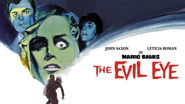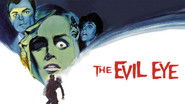LeonLouisRicci
This Seminal "Giallo" Film, Directed by Mario Bava, is one of those that was "Split" into Two Versions. The International and the American. While there are certainly "Differences" in the Two in terms of Tone, Musical Score, and other "Insertions" and Cuts, it Remains Influential and Interesting in Both Versions.Leticia Roman and John Saxon are in front of the Bava Visuals and Roman is Strikingly Beautiful as a Harrowed Heroine and Her Acting is Superb. Saxon, on the other hand Over Emotes although is Adequate as a "Sidekick" to the Leading Lady.The Film is Sighted as the First "Giallo", however Bava's (and in Color) "Blood and Black Lace" (1964) is a Better Introduction and Fully Fledged. By the way, this is Bava's last Black and White Movie and His use of Color is Predominantly the Signature Style of this Italian Auteur.That's not to say His B&W Films lack Style. This, along with "Black Sunday" (1960) are Great Examples of a Director of Photography who could Illuminate and Shoot Striking Images in any Format. All of Bava's Movies are Visually Stunning, Creative, and Fun. His use of the Medium as an Artist's Playground was Immensely Influential for other Practitioners and Directors.The Story can be Befuddling to Follow, especially in the American Version, but it Matters Not. The Agatha Christie Mystery Formula is there as are the Twists and Turns, Red Herrings, and when all's Said and Done the Movie is Fun, Great Looking, and an Example of Mario Bava's Style (Eye) that made His Movies Magnificent Mini-Masterpieces in the B-Movie Market.Bava's Groundbreaking way of Making Movies has Gained and Maintained a Legacy of Legendary Status and is Commented Upon Repeatedly to this Day by Film-Makers and Fans.
grahamcarter-1
'Giallo' initially found its roots in the German 'Krimi.' These were adaptations of British writer Edgar Wallace mystery and crime stories, made specifically for the German market between 1959 and 1972. 'Giallo' were more baroque in style and notable for extended murder sequences, stylish camera work, and Grand Guignol style drama. Full of madness, alienation and paranoia; atmosphere is everything and character development, acting, and strong pacing are immaterial. Unlike the American horror / stalker / slasher / final-girl films, the killer is rarely male or suffers from gender confusion that places him in the feminine position; Argento's The Bird With The Crystal Plumage (1970) is an example, as is Fulci's A Lizard In A Woman's Skin (1971). Almost as a convention, 'Giallo' titles frequently feature animals or numbers, such as Fulci's Don't Torture a Duckling (1972), or Umberto Lenzi's Seven Blood Stained Orchids (1972). Mario Bava's "The Girl Who Knew Too Much" (1963) is considered the first 'Giallo' film. A cinematographer who received his first chance to direct finishing Riccardo Freda's 1956 I Vampiri (which is considered the first Italian horror film), Bava then handled cinematography and special effects on Hercules (1957) kick starting the sword and sandal genre. He shot The Day The Sky Exploded (1958), which is the first Italian sci-fi film, with a large German 'Krimi' cast. He then had a chance to shoot and finish directing another Freda film, Caltiki – The Immortal Monster (1959), a genre favourite. It is remarkable to watch Planet Of The Vampires (1965) and then take a moment to think about whether Alien (1979), could exist without it (answer? It couldn't). Bay Of Blood / Twitch Of The Death Nerve (1971) was hugely influential in regards the American 'slasher'/'body count' genre. The Girl Who Knew Too Much establishes what will become one of the critical conventions of 'Giallo,' that of an outsider or foreigner who witnesses a murder and investigates the crime. Trouble comes when warnings not to get involved are ignored. 'The Girl…' is more restrained than any of Bava's later 'Giallo,' in which he would develop a baroque and garish use of colour. Filmed in black and white that connects it to film-noir (the literary-pulp origins of 'Giallo'), and Hitchcock's influential Psycho (1960, and the title refers to Hitchcock's 1934 and 1956 The Man Who Knew Too Much), Bava mixed in the conventions of the thriller, film noir and horror creating 'Giallo.'Check it out!
Scott LeBrun
"The Girl Who Knew Too Much", a.k.a. "Evil Eye", is a typically stylish effort for the renowned Italian filmmaker Mario Bava. It's a Hitchcockian thriller with excellent use of locations, the kind of palpable atmosphere that the master was capable of creating, endearing characters, and fairly restrained use of violence. Some Giallo fans may feel that the comedy content is simply too much, and that the body count is too minimal, but the director does tell a decent story (he was also one of the credited screenwriters) that wraps up within a reasonable amount of time.Leticia Roman stars as Nora Davis, an attractive young American woman vacationing in Rome. During one eventful night, she is mugged, and in something of a daze afterwards, witnesses what looks to be a murder. She even sees a character that could only be the killer. But many people are very quick to disbelieve anything she says, simply because she's addicted to murder mystery novels, and they think that she's got an active imagination. John Saxon co- stars as Marcello Bassi, a dashing young doctor who takes a romantic interest in her.The mystery here is actually a little more straightforward than some viewers might expect. The reveal of the killers' identity doesn't come as any great surprise. But the journey to that destination is worth taking, with some ingenious cutting (by Mario Serandrei) and good pacing. Considered by many to be one of the earliest examples of that Italian genre known as the Giallo, it contains some wonderfully striking imagery and wonderful lighting by Bava himself. Lovely Roman and studly Saxon are charming leads, and they are well supported by Valentina Cortese as the gregarious Laura and Dante DiPaolo as the disgraced reporter Andrea Landini.A must for Bava fans and devotees of the Giallo.Seven out of 10.
morrison-dylan-fan
As the end credits to Dario Argentos Four Flies on Gray Velvet started to appear,I began to feel a little bit down,due to knowing that there would be along gap,before I got to Argentos return to the genre in the nineties.As I picked up the DVD,to the next Argento film that I was going to watch, (the mind-bending,amazing supernatural horror film Suspiria) I suddenly noticed a box set of Mario Bava films,which I had picked up a week or so ago.Checking to see what films were in the set,I almost jumped with joy,when I saw that this film (which I have heard friends mention to me,as the film that created the Giallo film genre!)was in the set.With finding the choice of which one to watch that night very tough,I decided to instead watch both (of what turned out to be,truly amazing films) back to back.The plot:Whilst on a long plane journey,to get to Rome for her holiday.Nora Davis tries to pass the long flight by reading a pulp murder mystery/thriller book,as the plane gets close to landing,the passenger who has been sitting next to Nora for the whole flight,offers her a free pack of cigarettes.Accepting the kind offer,Nora and all of the other customers go to the luggage checking part of the airport.Getting closer to the front of the check out desk Nora is shocked,when the man who passed her the cigarettes is grabbed by the police,due to attempting to bring marijuana cigarettes into the country.Having finally got through customs without them finding the cigarettes on her,Nora goes to visit her aunt,who has sadly been pretty ill recently,although she does seem to be getting better,thanks to the care and attention of the very polite and caring DR. Marcello Bassi.With it being very late into the night,Marcello gives Nora his phone number,and tells her the address of the building that he is living in near by.During the night,Noras aunt suffers a huge cardiac arrest and dies,Nora quickly grabs the phone to ring Marcello,although sadly with a huge thunder storm happening,all of the phone lines are down.Fearing that the longer she stays in the house,the less chance there is of her aunt being helped at all,Nora decides that she will go outside,and run to Marcellos house.Almost as soon as she is outside,Nora is grabbed by a mugger,who pushes her to the ground,and steals her purse..As she struggles to get up,Nora is left breathless, when she sees a woman get brutally stabbed near by.When the killer looks up and Nora sees the face of the man,all of the terror inside Nora causes her to faint. The next morning she is woken up in the street by a policeman,who thinks that she must be drunk due to her "crazy ranting" about seeing a woman getting murdered.With no sign of the body,and the thunderstorm having rushed away any sign of blood,the police and Bassi (who genuinely tries to find any evidence of a murder taking place) start to wonder if Nora may have just imagined it all,due to seeing her aunt die.During the funeral of her aunt,a woman called Laura,gives Nora the kind offer that she can stay at her place,whilst she tries to sort her self out.Accepting the offer,Nora and Bassis suspicions suddenly start to return,when they begin to notice that most of the local towns Falk seem very stubborn about saying anything,and instead want to keep themselves out of anything.Thankfully for both of them,Nora discovers some very dusty newspapers in a corner of the house she is staying in,which have articles about a serial killer called "the alphabet killer",who seems to pick the pick the victim,whose last name starts with the next letter of the alphabet.Although both of them are thrilled that they have at last got something to go on,Nora suddenly realises that she is in this deeper than she through,when she gets a strange phone call asking her to confirm that her last name starts with the letter D... View on the film:Whilst MGM have sadly kept the American cut of the film (titled:The Evil Eye) in storage,with no sign of it ever having come out on Video/DVD (Luckally,the fantastic commentary by Tim Lucas on the Italian cut, goes into a lot of detail about the "missing scenes")After having a very catchy Roberto Nicolosi song play over the opening,Mario Bava starts brilliantly entering the viewer into Noras gradually fearful,paranoid- fulled world.From the moment in the film where Noras passenger "friend" is taking by the police,Bava (who also wrote the stunning screenplay,along with four other people)begins to show that Nora really wishes that this was a bad dream,due to her only experience with violence being from pulp novels.One thing that really struck me during my viewing of the film,were the very clever nods to Carol Reeds classic 1949 British Noir film The Third Man,with Noras constant attempts to get any of the townsfolk to open there mouths or believe her about seeing the murder,which most of them,including Bassi begin to think that it is an event which never took place.Bava also shows the huge impact this film would have on the Giallo genre,with Noras troubles of not knowing whats real or fake,and the activates of the killer,being something which clearly influenced Dario Argento and other similar film makers.for his directing,Bava gives the film a fantastic,almost haunted appearance ,with the scenes of Nora in the guest house,terrified of the killers sudden appearance,being filled with a huge amount of tensions,thanks to a very clever suspense building building appearance,and a fantastic performance from the beautiful Leticia Roman as Nora Davis. Final view on the film:An astonishing Giallo,that towers above most of the things that it inspired,due to having a stunning edge-of the seat screenplay,very strong performances and extremely creative,classy directing from the brilliant Mario Bava.






